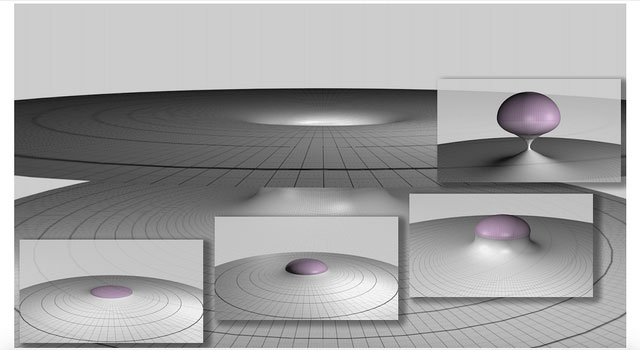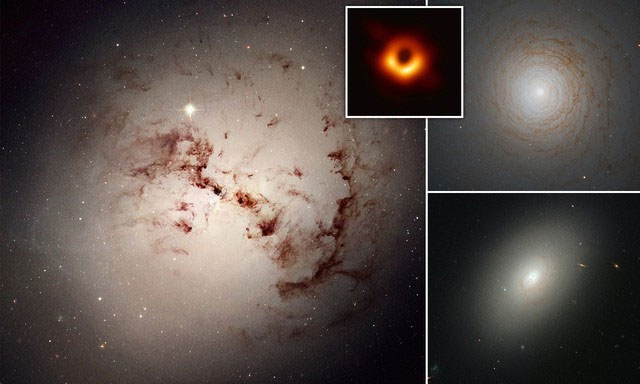The mystery of the origin of the universe: Can each black hole give birth to a baby universe and do we live in a black hole?
Is our universe a black hole? This is a difficult question to answer accurately, however many astronomical phenomena show that this statement is not impossible.
Some scientists suspect that humans could live inside a giant black hole and that the universe as we know it is a newborn universe that was nurtured inside this black hole. What's even more astonishing is that some researchers believe there could be an independent universe inside each black hole. So what have scientists discovered?

Many scientists suspect that humans can live inside a giant black hole. (Illustration).
Einstein's 1915 theory of general relativity is like a bright star, lighting up the physical sky. This theory not only predicts the curvature of space-time but also reveals a profound connection between mass and gravity.
German astrophysicist Karl Schwarzschild used this theory to calculate the vacuum solution. Under certain extreme conditions, space-time can be infinitely deformed to form a point of infinite density and infinite volume, i.e. the Singularity.
Around the singularity, space and time seem to be twisted tightly by an invisible hand, forming an impassable boundary - the event horizon . The event horizon is like a bottomless hole that not even light can escape, so scientists call it a black hole. At the depths of a black hole, traditional laws of physics no longer apply and the concepts of time and space become blurred. This prevents us from observing what is going on inside the black hole and calculating the strange phenomena that may occur there.

Stellar black holes are formed by the internal collapse of massive stars at the end of their lives. (Illustration).
As scientists continue to study black holes in depth, we gain a better understanding of black holes in the universe. In general, black holes can be divided into two main types: stellar black holes and primordial black holes . Stellar black holes are formed by the internal collapse of massive stars at the end of their lives. Not all stars eventually evolve into black holes. Only stars with a mass greater than 25 times the mass of the Sun can form black holes.
When a giant star runs out of nuclear fuel, the internal gravity is no longer balanced by the recoil of nuclear fusion, causing the star's interior to collapse. If the star is large enough, the contraction will create a very dense object called a black hole.
Another type of black hole is a primordial black hole , which has a very different shape than a stellar black hole. Primordial black holes may have originated during the inflationary period after the Big Bang. At that time, the universe experienced a period of extremely high temperature and high energy, and the density of matter reached its limit. In this case, some regions could undergo direct collapse, forming primordial black holes.

Primordial black holes may have originated during the inflationary period after the Big Bang. (Illustration).
In addition to these two types of black holes, Einstein's theory of relativity also predicts a third type of black hole, containing a singularity inside, which is considered the origin of the Big Bang. This leads to an intriguing hypothesis: is our universe a giant black hole?
According to modern scientific research, our universe was born from a Big Bang about 13.8 billion years ago. This big bang originated from a very small singularity containing all matter and matter. energy. This has led some scientists to speculate that our universe may actually be the inner world of a black hole.
In the process of discovering the origin of the universe, scientists discovered an interesting phenomenon: the actual horizon size of the universe is actually very close to the event horizon size of the black hole, in Even light cannot escape this boundary. Similarly, the expansion theory of the universe describes a rapidly expanding universe after the Big Bang, in which space-time expanded faster than the speed of light, making it impossible for us to see or observe the outside. outer space.
Through observations and calculations of the universe, astronomers have estimated the total mass of the universe to be about 10^54 kg . Substituting this mass into the Schwarzschild radius formula , we can see that the Schwarzschild radius of the universe is approximately 150 billion light years, meaning that the diameter of the universe is approximately 300 billion light years.
For comparison, the diameter of our currently observable universe is about 93 billion light-years. Based on these observations, some scholars have proposed a hypothesis: We could live inside a black hole.
Many years ago, the famous physicist Hawking proposed the hypothesis of a "nascent universe", which has been increasingly improved over time. So what is the " nascent universe" ? Simply put, it means that our universe was born from a larger mother universe and there are countless child universes within this mother universe. Hawking believes that there could be a newborn universe inside every black hole in the universe, which means the same thing happens inside all the black holes in our universe.

The total mass of the universe is about 10^54 kg.
Furthermore, every time a new black hole is formed, it can also symbolize the birth of a new newborn universe. This means that the universe could be infinite, it could even be said that every second a new sub-universe is born. The black hole's critical value is similar to the radius of our current observable universe.
You might think this is just a coincidence, but for scientists who believe we live inside black holes, this is considered another piece of evidence supporting the "nascent universe hypothesis". If there is a newborn universe inside every black hole, that also means every black hole could have life.
Considering that the number of black holes is infinite, this also implies that in the mother universe there must be countless lives and civilizations, and humans are just an insignificant existence among them. In this way, concepts such as multiverse and parallel universe can also be clearly explained. Einstein previously suggested that black holes could serve as conduits between universes. Does this mean that to reach a parallel universe or another time and space, we just need to enter a black hole?

If there is a newborn universe inside every black hole, it means that every black hole has life. (Illustration).
Perhaps one day in the future, when humans can reach the edge of the universe, we will have the opportunity to discover the truth about the universe. Or when human technology advances to the point of being able to explore black holes, we may be able to solve all these mysteries.
However, currently there is no convincing evidence to confirm whether the universe is a giant black hole or not . Although we still have many unanswered mysteries about the nature of the universe, this does not prevent us from appreciating its magnificent sights. Is our universe a black hole?
- Discover the mystery of the most exotic black holes in the universe
- The mystery of the black hole and the new hypothesis of the birth of the universe
- 10 fascinating facts about black holes
- The universe can be produced from black holes
- Universe origin according to Stephen Hawking's theory
- New hypothesis of cosmic formation
- Mystery of the black hole: Where people divide themselves?
- 740 million light years away is a completely different universe of black holes
- Science warns super giant black holes that can
- The supermassive black hole was discovered 34 billion times larger than the Sun.
- Black holes may have grown differently when the universe was 'younger'
- What will a baby born in the universe look like?
 Van Allen's belt and evidence that the Apollo 11 mission to the Moon was myth
Van Allen's belt and evidence that the Apollo 11 mission to the Moon was myth The levels of civilization in the universe (Kardashev scale)
The levels of civilization in the universe (Kardashev scale) Today Mars, the sun and the Earth are aligned
Today Mars, the sun and the Earth are aligned The Amazon owner announced a secret plan to build a space base for thousands of people
The Amazon owner announced a secret plan to build a space base for thousands of people